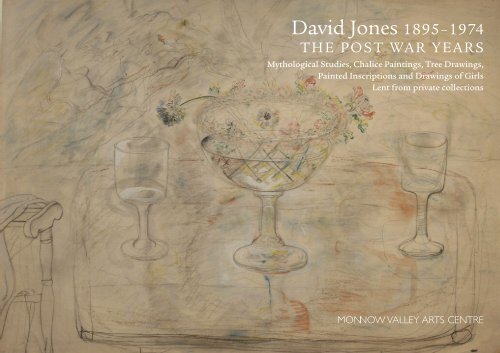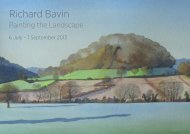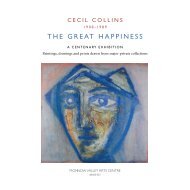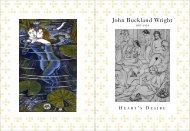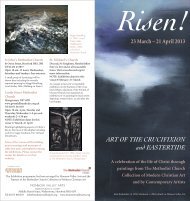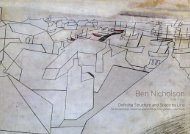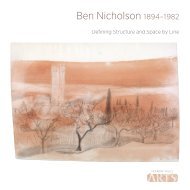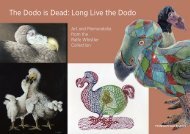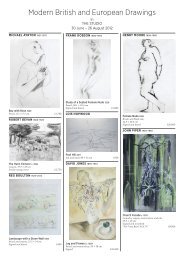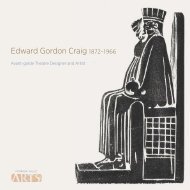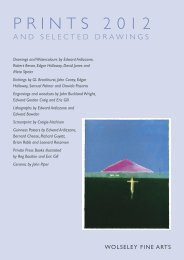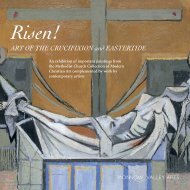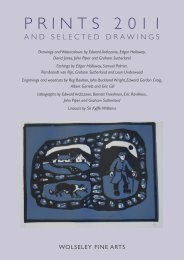David Jones 1895â1974 - Monnow Valley Arts Centre
David Jones 1895â1974 - Monnow Valley Arts Centre
David Jones 1895â1974 - Monnow Valley Arts Centre
- No tags were found...
You also want an ePaper? Increase the reach of your titles
YUMPU automatically turns print PDFs into web optimized ePapers that Google loves.
3. A Latere Dextro 1943–9Pencil, chalk, watercolour and gouache,61 × 47 cmLiterature: The Maker Unmade, page 261,illustratedThe Paintings of <strong>David</strong> <strong>Jones</strong>, plate 64illustratedExhibited: <strong>David</strong> <strong>Jones</strong>, Tate Gallery, no 129illustrated<strong>David</strong> <strong>Jones</strong>, A Map of the Artist’s Mind,National Museum & Galleries of Wales,catalogue no 5, illustrated page 32.THE DAVID JONES ESTATEIn this highly worked painting, <strong>Jones</strong> depictsthe Mass at the moment the wine is changedinto the Blood of Christ. The title comes fromSt John’s account of the crucifixion whereChrist’s body is pierced on the right side(a latere dextro).35
4. St. <strong>David</strong> 1947/48Ink and gouache on paper, 38.2 × 28 cmInscribed Dewi Ddyfrwr gweddia dros CymruPRIVATE COLLECTION5. Eclogue IV 1949Pencil and touches of coloured crayon andgouache, 60 × 47 cmSigned and dated lower rightLiterature: The Paintings of <strong>David</strong> <strong>Jones</strong>, plate66 (illustrated)Exhibited: <strong>David</strong> <strong>Jones</strong>, <strong>Arts</strong> Council touringexhibition 1954, no 67<strong>David</strong> <strong>Jones</strong>, Tate Gallery no 128illustratedPhotograph by kind permission of CeciliaGrayHELEN SUTHERLAND COLLECTION6. Study for Eclogues – 1 1949Pencil, 41 × 33 cmTHE DAVID JONES ESTATE7. Study for Eclogues – 6 194941 × 33 cmTHE DAVID JONES ESTATEIn these drawings an Angel is caughtdescending to earth to shepherds in the field.The title comes from Virgil where a passage inEclogue IV is said to refer to the prophecy ofthe Incarnation.65
6 78. Gwener 1959Watercolour, gouache and pencil, 38 × 57.2 cmLiterature: The Maker Unmade, page 273,illustratedExhibited: <strong>David</strong> <strong>Jones</strong>, Tate Gallery 1981, no.138VALERIE WYNNE-WILLIAMSCOLLECTIONIn this painting, originally called the Lee-Shore, <strong>Jones</strong>’ muse, Valerie Price, is showngazing out to sea surrounded by elementsfrom the Mass and from Welsh folklore87
C H A L I C E PA I N T I N G S<strong>Jones</strong> develops the first Chalice paintings out ofstill life works made at Pigotts in 1932. This themeis re-visited in the early 1950s. In these paintings,which <strong>Jones</strong> rated highly in his oeuvre, a vase isplaced in the centre of the composition on a tabletop. The table represents an altar and the flowersthe chalice. Usually the central chalice will containbriar roses to represent the crucifixion. Whereother goblets or chalices are present they willrepresent the two thieves crucified with Christ.Objects on the table top will also have significancesuch as a necklace being a metaphor for theRosary.^9. Gwyl Ddewi (Chalice with Daffodils)1950Watercolour, chalk and gouache, 66 × 75 cmSigned and dated lower rightExhibited: <strong>David</strong> <strong>Jones</strong>, <strong>Arts</strong> Council touringshow 1954, no 71<strong>David</strong> <strong>Jones</strong>, Tate Gallery 1981, no. 133HELEN SUTHERLAND COLLECTION10. Chalice and Goblets c. 1950Pencil, watercolour and gouache, 56 × 76 cmPRIVATE COLLECTIONAn unfinished study with a similararrangement of objects as in Flora in Calex-Light 1950Illustrated on front cover11. Chalice with Flowers and Pepper Potc. 1954Pencil, crayon and watercolour, 79 × 57.5 cmLiterature: Dai Great Coat, illustrated oppositepage 163Exhibited: <strong>David</strong> <strong>Jones</strong>, Tate Gallery 1975.PRIVATE COLLECTIONIllustrated on page 212. Toureen c. 1954Pencil, crayon and watercolour, 77.5 × 56 cmAn unfinished studyPRIVATE COLLECTIONT R E E D R AW I N G SAfter <strong>Jones</strong>’s second mental breakdown in 1947, hesettled in a room at Northwick Park Lodge inHarrow. As he had done whilst in the nursinghome, Bowden House, <strong>Jones</strong> drew the trees fromhis room, initially as therapy and later as an act ofengaging again with nature. Many of thesedrawings were exhibited at the Redfern Gallery in1948 and although not immediately appreciated bythe critics, were well received by the public andhave become some of the most iconic images in<strong>Jones</strong>’s post war work.13. Tree at Northwick Park (with PlayingFields) 1948Watercolour, crayon, chalk and pencil,76 × 58 cmLiterature: The Maker Unmade page 200illustratedPRIVATE COLLECTION14. Tree Harrow (April is the CruellestMonth) c. 1948Pencil, crayon and watercolour wash,78 × 57 cmPRIVATE COLLECTION15. Tree with Hen-Coop c. 1948Pencil, watercolour and crayon, 61 × 49 cmPRIVATE COLLECTIONIllustrated on inside front cover89
13 149
PA I N T E D I N S C R I P T I O N SAlthough <strong>Jones</strong> is recorded as having made hisfirst painted inscription in 1932, it is clear that hisapproach to lettering had developed much earlier.Some of the wood engravings from the Ditchlingdays incorporate lettering as did the copperengravings of the late 1920s. However <strong>Jones</strong>abondoned engraving in 1930 and this form ofexpression gave way to painting his own sepecialform of letters in watercolour. Letters areirregularly spaced and sized. Colour is used toemphasise certain words and languages are mixedup. The two dimensional space appears to pushand pull at the spaces between the letters, creatinga rhythmic flow that enchants the eye.Most of these works were made as personalgifts to friends. Texts are drawn from the Bible orother sources that have particular resonance forthe event being celebrated or the intendedrecipient. The exercise of making the inscriptionshowever was laborious. Many drafts andexperiments were carried out for each as <strong>Jones</strong> wasessentially inventing the art form as he went along.<strong>Jones</strong> preferred non English texts as this helpsthe viewer concentrate on the visual impact of thework and not on the meaning of the words whichcomes later.16. Ut Tua Gratia Largiente 1947Black and red watercolour, 30.5 × 39 cmLiterature: The Painted Inscriptions of <strong>David</strong><strong>Jones</strong>, No. 10, page 28HELEN SUTHERLAND COLLECTION17. Veni Pater Pauperum 1949Watercolour, 19 × 32 cmInscribed For Louis from <strong>David</strong> <strong>Jones</strong> Whitsun1949 on reversePRIVATE COLLECTION1017
18. Regis Insulae 1955Three watercolour inscriptions mountedtogether, 18 × 32.5 cm, 17 × 20 cm and 13 ×32.5 cmLiterature: The Painted Inscriptions of <strong>David</strong><strong>Jones</strong>, ref. viii, ix, x, page 95PRIVATE COLLECTION19. Chris Ein Pasq c. 1950–5Watercolour, 17.5 × 31 cmLiterature: The Painted Inscriptions of <strong>David</strong><strong>Jones</strong>, No. 35, illustrated page 68Exhibited: <strong>David</strong> <strong>Jones</strong>, Tate Gallery 1981, no152PRIVATE COLLECTION1920. Dewi Wynfydedig 1959Watercolour, 15.2 × 24 cmSigned and dated 1 March 1959Literature: The Painted Inscriptions of <strong>David</strong><strong>Jones</strong>, ref. no 48, illustrated page 84VALERIE WYNNE-WILLIAMS COLLECTIONIllustrated on back cover21. Dyma Arwr Mawr 1960Watercolour, 13 × 19 cmSigned and datedLiterature: The Painted Inscriptions of <strong>David</strong><strong>Jones</strong>, ref xvii, page 96VALERIE WYNNE-WILLIAMS COLLECTION2111
G I R L S<strong>Jones</strong> was engaged to Eric and Mary’s Gill’sdaughter, Petra, from 1924–28. Petra was his firstmuse, Prudence Pelham his second and ValerieWynne-Williams the last. <strong>Jones</strong> loved women butnever married and in his later life poured out hisfrustrations in numerous drawings of imaginarygirls based on his muses.Most of these drawings were hastily done with afew being worked up into more finished workswith colour being added either in coloured crayonor watercolour and gouache. They do not seemever to have been exhibited and were intended asgifts or were left in the estate when he died.They represent a significant aspect of <strong>Jones</strong>’work which has not been properly researched asyet.25. Woman Warden During the Blitz 1941Watercolour and pencil, 32 × 20 cmLiterature: The Maker Unmade, page 257illustratedPRIVATE COLLECTIONWhen the Blitz started <strong>Jones</strong> was “stirred ...bybeautiful girls wearing steel helmets at jauntyangels” (Maker Unmade page 257).Illustrated on page 326. Girl Putting on her Glove c. 1948Pencil and coloured crayon, 32 × 20 cmPRIVATE COLLECTIONIllustrated on page 143113
142630
27. Woman Looking Right c. 1948Pencil and watercolour, 51 × 37 cmTHE DAVID JONES ESTATE28. Woman Looking Left c. 1948Pencil and watercolour, 56 × 36 cmTHE DAVID JONES ESTATE29. Woman Looking Out c. 1948Pencil and watercolour, 50 × 36 cmTHE DAVID JONES ESTATEIn these drawings of girls observed at Mass,the profiles remind one of Petra Gill who hadmarried Denis Tegetmeier in 1930.30. Girl Tying a Bow c. 1950Pencil and coloured crayon, 31 × 19.5 cmPRIVATE COLLECTION31. Girl Sitting by a Stream 1950sPencil and watercolour, 32 × 20 cmLiterature: The Paintings of <strong>David</strong> <strong>Jones</strong>, no.60 (illustrated)PRIVATE COLLECTIONIllustrated on page 133232. Girl with a Bonnet 1950sPencil and coloured crayon, 32 × 20 cmPRIVATE COLLECTION33. Woman and Child at Mass c. 1958Pencil, 37 × 27 cmExhibited: <strong>David</strong> <strong>Jones</strong>, <strong>Arts</strong> Council 1989, no.61THE DAVID JONES ESTATE3434. Two Girl Chaps c. 1959Pencil, pastel and gouache, 32 × 20 cmSigned lower rightVALERIE WYNNE-WILLIAMS COLLECTION15
35. The Three Graces 1959Gouache, pastel and pencil on paper laidon board, 33 × 20 cmSigned, titled and dated on reverseTHE DAVID JONES ESTATEThe title may refer to <strong>Jones</strong>’ three muses.36. Girl Asleep with Bows 1959Gouache, pastel and pencil, 32 × 19.5 cmIllustrated: The Maker Unmade page 273The subject is Valerie Wynne-WilliamsTHE DAVID JONES ESTATE37. Standing Girl, Back c. 1960Ink and crayon, 32 × 20 cmTHE DAVID JONES ESTATE38. Standing Girl, Head Bowed c. 1955Pencil and watercolour 32 × 20 cmTHE DAVID JONES ESTATE39. Girl Walking c. 1955Pencil and watercolour, 32 × 20 cmTHE DAVID JONES ESTATE40. Girl on Sofa c. 1960Pencil and watercolour, 32 x 20 cmTHE DAVID JONES ESTATE3541. Girl Standing with a Bouquet ofFlowers c. 1960Pencil and watercolour, 32 x 20 cmTHE DAVID JONES ESTATE1636
38 39


